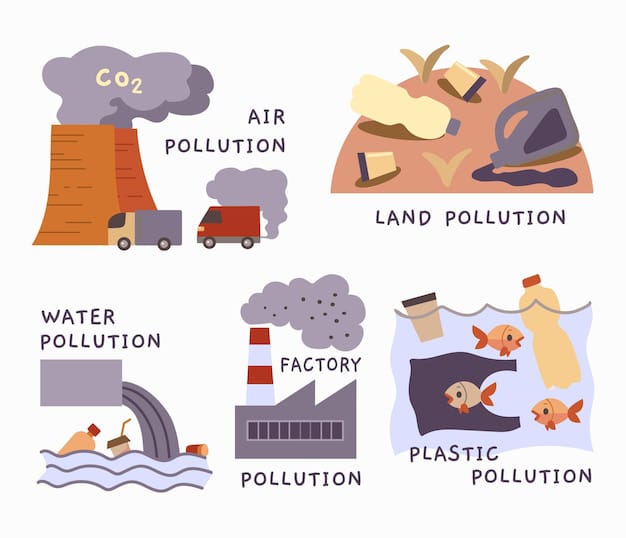Most human activities that result in degradation or degradation of the quality of the natural environment are called pollution. Pollution is not a new phenomenon, but it remains humanity’s greatest problem and the leading environmental cause of morbidity and mortality. In 2015, pollution-related diseases were estimated to cause 9 million premature deaths, three times the number of deaths from malaria, AIDS, and tuberculosis combined (Landrigan et al., 2017). In general, pollution is more severe in low- and middle-income countries than in developed countries, possibly due to poverty, inadequate legislation, and lack of information about forms of pollution. Perhaps people unknowingly encounter pollution on a daily basis or may become immune to its effects in their fast-paced lives (Muralikrishna and Manickam, 2017). Although it may seem impossible, ignorance about the forms of pollution leads people to engage in activities that produce harmful by-products in forms and quantities that the environment cannot compensate for without completely changing the system. can’t. For example, deforestation, burning of forests, dumping of agricultural and domestic waste into waterways, use of chemicals in the collection of aquatic animals, improper disposal of electronic waste etc. are the causes of air, land and water pollution. Also, as population density increases, human activities also increase, which at the same time increases the impact on the environment. This effect affects not only humans, but also other aquatic and terrestrial animals, including microorganisms, which, due to their abundance and diversity, maintain biochemical functions essential for the maintenance of ecosystems.
The causes of environmental pollution are not only limited to industrialization, urbanization, population growth, exploration and mining, but also cross-border transfer of pollutants from developed countries to developing countries and vice versa. Transboundary pollution is one reason why pollution remains a global challenge. Pollution in one country can have a devastating impact on another country through various routes, especially air and water. Therefore, no country can remain indifferent to environmental pollution. Cross-border transportation of non-functioning electrical and electronic equipment (EEE) from developed countries to developing countries in the name of bridging the digital divide is also a serious cause of toxic metal pollution in air, water and soil. Furthermore, environmental pollution is caused by the release of harmful substances such as gaseous pollutants, toxic metals and particulate matter (PM) into the air and water bodies such as sewage, industrial and agricultural runoff and electronic waste.
It is not uncommon to feign ignorance when it comes to the fact that human activities are destabilizing the natural environment. Thus, such activities continue even when they cause serious illness and death. In low- and middle-income countries, some human activities found to be harmful to the environment are still carried out, either because of inadequate legislation, delayed enforcement of penalties, or indifference to the health and environmental impacts of such activities. . The effects of environmental pollution, especially air pollution, are dangerous and disproportionately affect low-income people, children, the elderly, and other vulnerable groups in developing countries.
Knowledge of the causes and consequences of pollution is paramount, but the cost of inaction is very high. Various physical and chemical methods have been used to remove environmental pollution, but most of them cause environmental problems and are expensive. To truly combat pollution with emerging persistent pollutants, the literature has explored environmentally friendly and economical methods that generate fewer secondary by-products. Among these methods, microbial bioremediation is being explored worldwide. This is probably because restoring the environment in this way is practical and environmentally friendly. There are many different types of pollution, but three main types of pollution should be considered: air pollution, water pollution, and soil pollution.
Main Types Of Pollution
Air Pollution
Air pollution can be defined as the presence of toxic compounds in the atmosphere that can be harmful to animals, vegetation, buildings and humans. In general, air pollution means the presence of chemicals in the atmosphere that were not originally there but which have caused deterioration in air quality. Air pollution also negatively affects the quality of life on Earth through global warming and destruction of the ozone layer. Pollutants have different characteristics and their distribution and effects are diverse depending on the source, form and conditions. Common gaseous pollutants include sulfur oxides (especially SO2), nitrogen oxides (including NO and NO2), volatile organic compounds (VOCs), and carbon monoxide (CO). These gaseous pollutants are divided into primary and secondary pollutants. Primary pollutants (e.g., CO, CO2, NO2, SO2, etc.) are those pollutants that are typically emitted directly into the atmosphere from domestic, industrial, and transportation sources, while secondary pollutants are those gases and particles that are primarily released into the air. Are present. Primary pollutant. For example, ammonium nitrate aerosols, sulfuric acid, and the breakdown of hydrocarbons produce atmospheric nitrogen oxide gases, atmospheric sulfur, and ozone (O3).
The extent of harm caused by air pollutants is determined primarily by their chemical structure, including oxidation potential, solubility, concentration, and sensitivity of the affected person or object. In humans, SO2 gas has high solubility in water and can damage the skin and upper respiratory tract, while O3 and NO2 have low solubility and can penetrate deep into the lungs. CO is a colorless, odorless, highly soluble, non-irritating gas that has a higher affinity for hemoglobin than oxygen. Therefore it easily enters the bloodstream and forms carboxyhemoglobin, which has harmful effects. PM is usually classified according to its size or aerodynamic diameter. PM10 refers to particles with a diameter of 10 mm. The diameter of PM2.5 particles is 2.5 mm, and the diameter of PM0.1 particles is 0.1 mm. Large particles visible as dust can be carried by the wind and deposited on buildings and structures, and can also get into human eyes. Some harmful pollutants, such as polycyclic aromatic hydrocarbons (PAHs) and persistent organic pollutants (POPs), are often found in emissions from incomplete combustion of organic materials. However, these pollutants can bind to particulate matter, travel long distances and settle in the environment, causing serious damage. Therefore, air pollution is considered to be the most serious type of pollution.
Water Pollution
Water pollution occurs from both human and natural sources. Ground water sources may contain natural ores rich in toxic metals which leach into water bodies and cause pollution. Cases of high levels of arsenic and lead contamination in groundwater sources have been linked to such ores. As Ivuzzi et al. (2020) reported that geological strata in different regions also contribute significantly to the elemental composition of water bodies, which may cause increased elemental concentrations that contribute to water pollution. Anthropogenic sources include household waste, pesticides and herbicides, food processing waste, livestock contaminants, VOCs, heavy metals from electronic waste, chemical waste, and medical waste. Suspended pollutants such as particulate matter also introduce other organic pollutants into surface waters. These pollutants can cause health problems like stomach ache, vomiting, diarrhea and typhoid fever. Chemicals such as pesticides, hydrocarbons, POPs and heavy metals can cause adverse health effects such as cancer, hormone imbalance, reproductive disorders and severe liver and kidney damage. Nutrients in water can cause eutrophication, plant growth and in some cases algae blooms, leading to oxygen depletion and further pollution.
Soil Pollution
Apart from earthquakes, erosion and other natural disasters that damage the soil, industrial and domestic wastes are the main causes of soil pollution. Soil pollutants include heavy metals, hydrocarbons, inorganic solvents, and organic solvents. Throwing garbage in vacant sites, burning garbage and improper land filling are the main causes of land pollution. Fossil fuels released from petrochemical plants, oil refineries and power plants also cause soil pollution. Petroleum exploration, refining and distribution by road transport often cause soil pollution. Land pollution by plastic has received worldwide attention due to the toxicity of the additives used in its production and the direct effects of plastic on plants and animals. Plastic waste on land is an eyesore, can seep into the soil and interfere with the absorption of nutrients by plants and entangle terrestrial animals in the soil. Soil pollution not only causes health problems, but can also alter plant metabolic processes and reduce crop yields. Contaminants can also enter the food chain through absorption by plants.
Read Also:
- Air Pollution And Its Control
- Awareness Note On Mobile Tower Radiation ; Its Impacts On Environment
- Extents Of Environmental Degradation
- Introduction to Environmental Degradation: Causes and Effects
- 20 Advantages of Environment








Leave a Reply